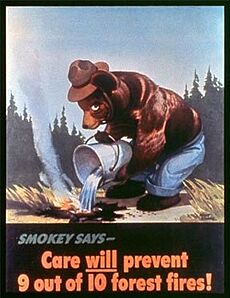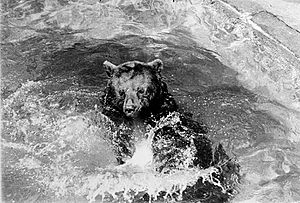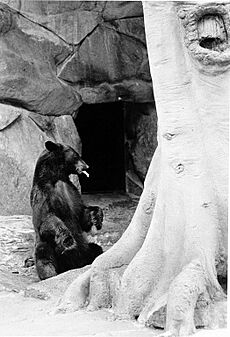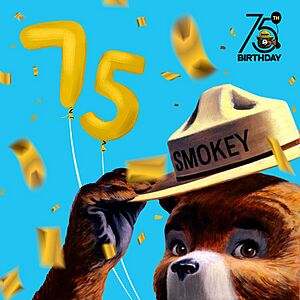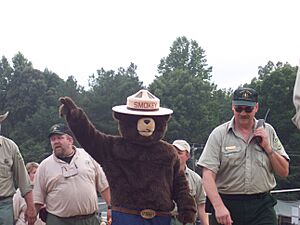Smokey Bear facts for kids
Quick facts for kids Smokey Bear |
|
|---|---|
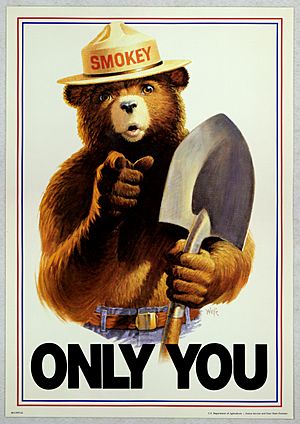
Smokey Bear in a poster based on the "Uncle Sam/Lord Kitchener Wants You" poster
|
|
| First appearance | August 9, 1944 |
| Created by | U.S. Forest Service, Advertising Council, National Association of State Foresters |
| Voiced by |
|
| Life | Spring 1950 Capitan, New Mexico (living mascot) November 11, 1976 Washington, District of Columbia |
| Biological Classification | |
| Species | Ursus americanus (American black bear) |
| Sex | Male |
Smokey Bear is a famous American symbol for preventing wildfires. He works with the U.S. Forest Service, the Ad Council, and the National Association of State Foresters. Together, they teach people about the dangers of wildfires caused by humans. This campaign is the longest-running public service message in United States history.
Smokey's first campaign started in 1944 with the slogan "Smokey Says – Care Will Prevent 9 out of 10 Forest Fires". His name is spelled "Smokey," not "smoky." In 1947, the slogan changed to "Remember... Only YOU Can Prevent Forest Fires." This message was used for a long time. In 2001, it became "Only You Can Prevent Wildfires." This change happened because many fires were starting in places other than forests, like grasslands. It also made it clear that Smokey wanted to prevent unplanned fires, not helpful fires used by experts to manage land.
In 2018, about 80% of people who enjoy outdoor activities knew who Smokey Bear was. Also, 8 out of 10 recognized his public service messages. Smokey Bear's name and image are protected by a special law called the Smokey Bear Act of 1952.
Contents
The Story of Smokey Bear
How Smokey Bear Started
The U.S. Forest Service had been fighting wildfires for a long time. But during World War II, it became even more important. Many firefighters were away serving in the military. This meant fewer people were home to fight fires. Leaders hoped that if Americans knew how fires hurt the war effort, they would help prevent them.
The Forest Service started using colorful posters to teach people about fire dangers. They wanted local communities to stop fires from starting. Careless people were not the only threat. The Empire of Japan even thought about using wildfires as a weapon. In 1942, Japanese submarines fired shells near Santa Barbara, California, close to a forest. Later, Japan launched about 9,000 fire balloons into the jet stream. Some of these reached the U.S. between 1944 and 1945. One balloon bomb sadly caused the deaths of Elsie Mitchell and five children in Bly, Oregon, in 1945.
The Campaign Begins
In 1942, the U.S. Forest Service started a program to prevent forest fires. On August 13, 1942, Disney's movie Bambi came out. Soon after, Walt Disney let his characters be used in fire prevention messages. However, Bambi was only available for one year. So, the Forest Service needed a new symbol.
After much discussion, they chose a bear. The idea came from a drawing by Forest Service artist Harry Rossoll. The bear's name was inspired by "Smokey" Joe Martin, a brave firefighter who was hurt saving people in 1922.
On August 9, 1944, Smokey Bear officially became the symbol for the Forest Service. This date is now celebrated as his birthday. The first Smokey Bear poster was made by artist Albert Staehle. In this poster, Smokey wore jeans and a campaign hat. He was pouring water on a campfire. The message said, "SMOKEY SAYS;– Care will prevent 9 out of 10 forest fires!"
In 1947, the Ad Council created the famous slogan: "Remember...only YOU can prevent forest fires." This slogan was used for over 50 years. In 2001, it changed to "Only You Can Prevent Wildfires." This was because fires were happening in many natural areas, not just forests. It also helped people understand that the campaign was about preventing unplanned fires, not controlled fires used for land management.
The Living Smokey Bear
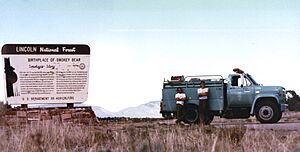
The real-life Smokey Bear was a small, three-month-old American black bear cub. He was found in the spring of 1950 after a wildfire called the Capitan Gap fire in New Mexico. Smokey had climbed a tree to escape the fire, but his paws and back legs were burned.
At first, he was called Hotfoot Teddy. But he was later renamed Smokey, after the cartoon character. A ranger named Ray Bell took the cub to Santa Fe. Bell, his wife, and their children cared for the little bear. The story became national news, and Smokey became famous. Many people wrote and called to ask about him.
The state game warden offered the cub to the US Forest Service. He wanted the cub to help with wildfire prevention. Smokey was then flown to the National Zoo in Washington, D.C.. When he arrived on June 27, 1950, hundreds of people, including Boy Scouts and Girl Scouts, were there to welcome him.
Smokey Bear lived at the National Zoo for 26 years. Millions of people visited him. He received so many letters, sometimes over 13,000 a week! In 1964, the United States Postal Service even gave him his own ZIP Code (20252), which is still used today. He loved peanut butter sandwiches, along with his daily fish.
In 1962, Smokey was given a female bear named "Goldie Bear." People hoped they would have cubs to continue the Smokey Bear legacy. In 1971, since they had no cubs, the zoo brought in "Little Smokey." This was another orphaned bear cub from the Lincoln Forest. They announced that Smokey and Goldie had "adopted" him.
On May 2, 1975, the original Smokey Bear officially "retired." Little Smokey then became "Smokey Bear II." Little Smokey passed away on August 11, 1990.
When the original Smokey Bear died on November 9, 1976, his remains were taken back to Capitan, New Mexico. He was buried at the Smokey Bear Historical Park. This park is now a center that teaches about wildfires and Smokey. His grave plaque says, "This is the resting place of the first living Smokey Bear ... the living symbol of wildfire prevention and wildlife conservation." Many newspapers, including The Washington Post and The New York Times, wrote obituaries for him.
Smokey's Popularity Grows
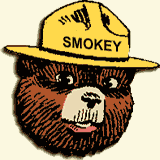
Smokey quickly became a big part of American culture. He appeared on radio shows, in comic strips, cartoons, and on many products. In 1949, Rudy Wendelin became the main artist for the campaign. He was like Smokey Bear's "manager" until he retired in 1973.
By 1952, Smokey Bear was so popular that the United States Congress passed the Smokey Bear Act. This law made sure that Smokey's image was protected. It also said that any money earned from using Smokey's image would go to wildfire prevention education.
Hill City High School in South Dakota is the only school allowed to use Smokey Bear as their mascot. This started in 1939 after students helped fight a forest fire.
In 1952, the Ideal Toy Company made Smokey Bear dolls. These dolls came with a card for children to sign up as Junior Forest Rangers. Children could also write to the U.S. Forest Service or Smokey Bear at his special ZIP Code. Within three years, half a million children had signed up!
Also in 1952, songwriters Steve Nelson and Jack Rollins wrote a popular song called "Smokey the Bear." The singer Eddy Arnold performed it. The songwriters added "the" to Smokey's name to make the song flow better. Because of the song, many people started calling him "Smokey the Bear," even though his official name never changed. A 1955 book in the Little Golden Books series was also called Smokey the Bear. This book showed him as an orphaned cub rescued from a fire, similar to the real Smokey. This was the first book about him, and many more books and coloring books followed. Soon, there were thousands of toys and collectibles.
During the 1950s and 1960s, the Ad Council made radio ads with Smokey Bear talking to famous people like Bing Crosby and Roy Rogers. Smokey's name and image are also used for the Smokey Bear Awards. These awards honor people who do great work in preventing human-caused wildfires.
In 1959, a large, moving Smokey Bear figure was shown at the Ohio State Fairgrounds. It was there to teach children and families about fire prevention. A new version of this figure was put in the same spot in 2015. Both figures have asked visitors to promise "never, ever play with matches or leave any fire unattended."
The Beach Boys even mentioned Smokey Bear in their 1964 song "Drive-In." Smokey's campaign hat became very famous because of him. Today, it is sometimes called a "Smokey Bear hat."
Smokey Bear Today
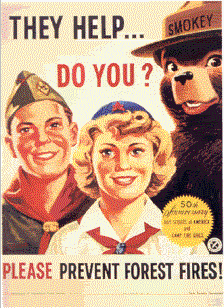
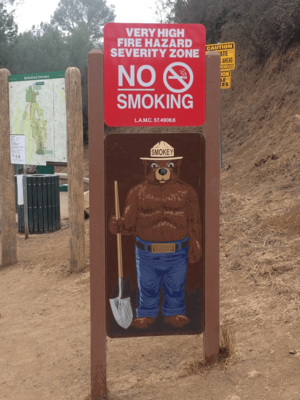
For Smokey's 40th birthday in 1984, he was honored with a U.S. postage stamp. It showed a cub holding onto a burned tree. The U.S. Forest Service also started collecting Smokey Bear materials at the National Agricultural Library. This collection includes posters, artwork, movies, and other items.
For his 50th birthday, a commercial showed forest animals planning a surprise party for Smokey. Smokey smelled smoke from the birthday candles and, not knowing what it was, used his shovel to destroy the cake! He apologized when he realized it was for him. A poster was also released that year saying, "Make Smokey's Birthday Wish Come True."
In 2004, Smokey's 60th birthday was celebrated. The Senate even passed a resolution for "Smokey Bear's 60th Anniversary." Experts say the Smokey Bear campaign is one of the most powerful and lasting public service campaigns.
In 2011, the campaign launched its first mobile app. It gives important information about preventing wildfires. This includes how to safely build and put out campfires. In 2012, NASA and the U.S. Forest Service celebrated Smokey's 68th birthday at NASA's Johnson Space Center. A plush Smokey doll even went to the International Space Station with astronauts!
In 2014, for his 70th birthday, new ads were released. They showed Smokey giving hugs to people who helped prevent wildfires. People were encouraged to share their own #SmokeyBearHug online. The campaign also worked with Disney's Planes that year. In 2016 and 2017, new ads focused on less common ways wildfires can start. Artists used wildfire ashes to create art for the "Rise from the Ashes" campaign.
For his 75th birthday in 2019, the Smithsonian's National Zoo opened an outdoor exhibit. It featured posters and photos of the original bear. A 6-foot-tall statue of the cartoon Smokey stood at the entrance. New commercials and events were held across the U.S. The Oregon Department of Motor Vehicles also released a Smokey Bear License Plate.
Smokey Bear in Culture
Smokey Bear is a very recognizable symbol. His image is often seen on clothing and other items. The chief of the Forest Service can allow his symbol to be used for educational purposes. They can also allow it for commercial products if it helps teach about fire prevention and does not harm Smokey's image.
Some state police forces are called "Smokeys" by truck drivers. This is because their officers wear the same type of campaign hat as Smokey Bear.
Who Voices Smokey Bear?
Washington, D.C. radio personality Jackson Weaver was the main voice of Smokey until he passed away in 1992. Dallas McKennon voiced Smokey in a 1957 cartoon. George Walsh voiced him in a 1960 animated short film. After Weaver, Gene Moss took over until he passed away in 2002. Other voices for Smokey have included Roger C. Carmel, Jim Cummings, and Jack Angel. Frank Welker also briefly voiced him.
In 2008, actor Sam Elliott became the voice of Smokey. He also got a new look to appeal to young adults. For Smokey's 75th birthday in 2019, new ads with emoji versions of Smokey featured the voices of Stephen Colbert, Jeff Foxworthy, and Al Roker. In 2024, for Smokey's 80th birthday, actor Brian Tyree Henry became the new voice.
Smokey Bear in Movies and Games
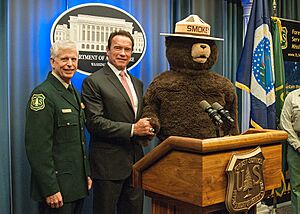
Smokey Bear has appeared in cartoons for over 50 years. In 1956, Smokey made a short appearance in the Walt Disney film In the Bag. In 1966, a stop-motion animated TV special called Ballad of Smokey the Bear was shown. A Smokey Bear balloon was also in the Macy's Thanksgiving Day Parade that same day.
From 1969 to 1970, there was a weekly cartoon series called The Smokey Bear Show. Even though his real name is Smokey Bear, the name "Smokey the Bear" is still popular. The song "Smokey the Bear" has been covered by music groups like Canned Heat.
The online game Fortnite: Battle Royale has a loading screen that makes fun of Smokey. It shows a character in a teddy bear costume with the message "Only YOU can prevent V-Buck scams." This warns players about fake offers for game money. Smokey is also briefly mentioned in the 2015 movie Open Season: Scared Silly.
Why Preventing Wildfires Matters

The main goal of Smokey Bear's campaign is to reduce wildfires caused by humans. The slogan changed from "Only you can prevent forest fires" to "Only you can prevent wildfires." This was to include all wildlands, like grasslands, not just forests. It also helped explain that Smokey is against unplanned fires, not controlled fires that are good for the environment.
For many years, people tried to stop all fires. But this can lead to too much "fuel" (like dead trees and plants) building up in forests. When a fire finally starts, it can become a huge "crown fire" that destroys everything. While large fires have always been part of nature, small, frequent fires can prevent fuel buildup. These small fires allow big trees to survive.
Some ecosystems, like Douglas fir and chaparral areas, actually need fire. Fire helps certain seeds open and grow. Wildfires also help keep pine barrens healthy by removing other plants that compete with the pines.
SmokeyBear.com explains that fire managers can use "prescribed fire." This means setting small, controlled fires under safe conditions. This helps reduce fuel and prevents huge, uncontrolled wildfires. However, Smokey Bear's main goal will always be to reduce human-caused wildfires and protect resources, homes, and lives.
See also
 In Spanish: Smokey Bear para niños
In Spanish: Smokey Bear para niños
- Johnny Horizon
- Mark Trail
- Woodsy Owl


